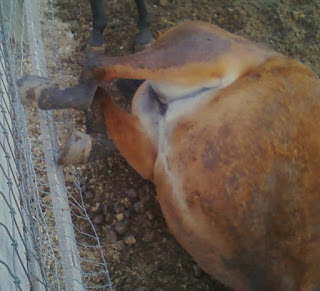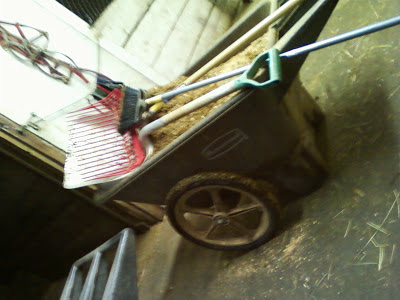Just the other day, I got a chance to talk to a lady who attended college solely for learning about horse genetics. A couple points she made were foreign to me, but I'll take her word for it for unless I hear otherwise from a reputable source.
First of all, I learned that approximately half the population of horses have a roan gene, but it doesn't always appear if it isn't prominent enough (so it isn't a dominant gene, it's recessive). Which explains how one of my friends got a chestnut roan from two solid chestnuts.
Also concerning roan, it is possible to get the roan gene from the sabino gene. So now Cayenne's coloring is possible, yay!
I asked her one more question- how do you get a bay from a palomino and a chestnut? Okay, this is the one piece of information that seems iffy-ish to me, so I'll have to look into it further. Either way, she said that palomino's can indeed be a black base color, but you cannot see it because of the palomino dilution.
EDIT: Now, I would disagree. One copy of a cream gene on black does not produce a palomino-colored horse. Turns out that the "chestnut" is actually a silver bay.
So, that's that. If I remember what I had wanted to write about, or find that list of topics to write about, I'll try to do another blog post soon. :) And one that's a bit more interesting.
Wednesday, November 28, 2012
Saturday, November 17, 2012
Cayenne - A Sabino Roan
Cayenne is an adorable miniature colt that is going to be weaned soon. Up to this past Tuesday, I have been thinking and thinking about his coloring, and trying to figure it out. Just to make things clearer for you, right now he appears to be a chestnut roan sabino.
As a foal, his owner and I thought he would just be a light chestnut with a fair amount of chrome (in the Miniature horse world, this means white or markings). After a bit of maturing we could tell that yes, he will have high lacy stockings on his hind legs, an apron face, and perhaps more. Then, we got to what puzzled me- he appeared to have roaning in his phenotype (appearance)!
Myself being into horse genetics and knowing the coloring of Cayenne's parents, here are some facts.
As a foal, his owner and I thought he would just be a light chestnut with a fair amount of chrome (in the Miniature horse world, this means white or markings). After a bit of maturing we could tell that yes, he will have high lacy stockings on his hind legs, an apron face, and perhaps more. Then, we got to what puzzled me- he appeared to have roaning in his phenotype (appearance)!
Myself being into horse genetics and knowing the coloring of Cayenne's parents, here are some facts.
- Roan is a dominant gene. If a horse has it, it'll show up.
- To get a true roan, one of the parents has to be a roan.
- Neither of Cayenne's parents were a roan.
- Pepper, the late sire, was a buckskin sabino.
- Birdy, Cayenne's dam, is a light solid palomino.
What I didn't remember until last Tuesday was that the sabino gene can include the roan gene (even if it isn't a true roan). Apparently Pepper had seemed roan until he was a yearling, at which time he lost the roaning, but still was sabino. (Not sure if that'd affect much or not though.)
My current hypothesis is that a sabino horse can yield a sabino foal with roaning, even if the parent was a roan-less sabino. I'm still trying to figure out how a different friend got a chestnut roan out of her two solid chestnut Walkers, but perhaps I'll discover the reasoning behind that one later. Or perhaps it was a freak accident, who knows? *shrugs*
To close, if you want to see a picture or few of Cayenne, here're a few from last Tuesday. :)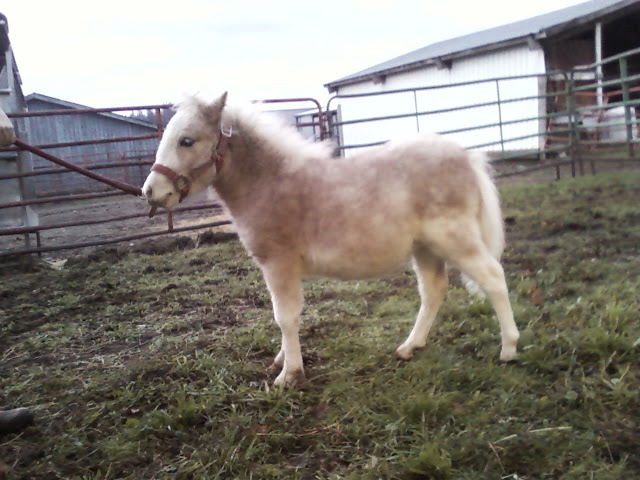 |
| Cayenne *finally* standing still for a picture. |
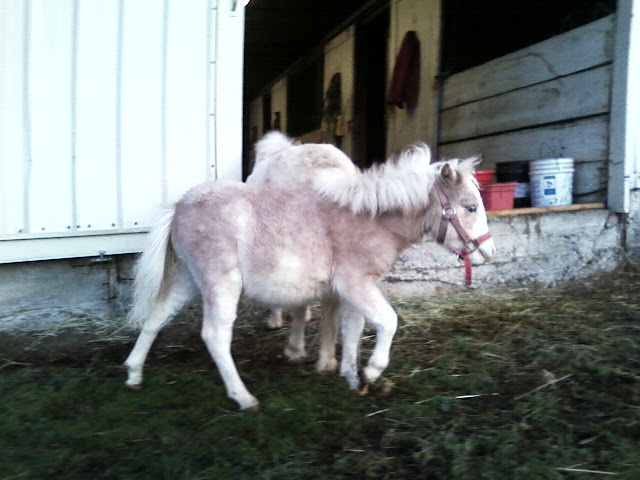 |
| And walking, which was rare for his energetic little self. |
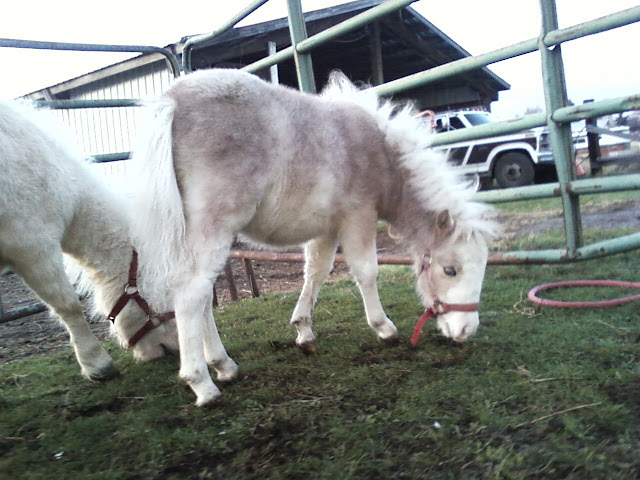 |
| Eatin' grass with Mommy. |
 |
| I got an itch, and I just gotta get it! |
Friday, November 16, 2012
A "Cast" Horse
If you've been around horse people a lot, but have not been around horses extensively, you've probably heard of when a horse gets "cast". If you are similar to me, you'll ask what it means multiple occasionthroughout time, but won't quite understand how it happens and why it is so dangerous. If you are even more like me, you may even Google the term, searching for pictures. And, similar to me again, you'll be unsuccessful.
A cast horse is a horse that has its hind legs stuck up against something, ergo not being able roll into a position to stand up. This gets dangerous after the horse has been cast for awhile, for the digestion system doesn't work very well will not in its normal orientation.
Thankfully, I have two pictures to share with you. These may be the only online pictures (for now) of a cast horse ever in history. Unfortunately they're both nasty quality, blurry, and perhaps even slightly warped as I took them with a cell phone camera. Either way, I'll show you them so you can understand the concept of a cast horse.
After the horse is un-cast, watch him for awhile. If the horse is eating and acting normal, that's good. If the horse acts like he has a tummy-ache, call your vet. Colic is nothing to shrug off.
A cast horse is a horse that has its hind legs stuck up against something, ergo not being able roll into a position to stand up. This gets dangerous after the horse has been cast for awhile, for the digestion system doesn't work very well will not in its normal orientation.
Thankfully, I have two pictures to share with you. These may be the only online pictures (for now) of a cast horse ever in history. Unfortunately they're both nasty quality, blurry, and perhaps even slightly warped as I took them with a cell phone camera. Either way, I'll show you them so you can understand the concept of a cast horse.
After the horse is un-cast, watch him for awhile. If the horse is eating and acting normal, that's good. If the horse acts like he has a tummy-ache, call your vet. Colic is nothing to shrug off.
Wednesday, November 14, 2012
A Brief Explanation of Colic
Colic is a very bad and possibly fatal condition a horse can get, and is the leading cause of unnatural death in horses. If you have horses, or a friend does, please read this, and let's keep safety first. =)
Colic is like a bad stomach-ache on a horse. The reason colic is terrible has to do with the tight muscles in the horse's esophagus, preventing the horse from regurgitating food. As such, the food either has to continue onward through the digestion process, or result in rupture or impaction (basically constipation). If the horse is blocked at both ends, this can fairly easily lead to colic.
Naturally, horses are not on the ground without their legs beneath them very often at all. So, being cast puts a horse in an awkward position, and remaining in this position for a prolonged period of time can cause colic. Especially if the horse is rolling and flailing around a lot, trying to free their legs.
As far as colic goes, the main safety is prevention, as well as catching it early on. Depending on how long the horse was cast, watch the horse for any signs of pain near the belly. Some of the possible signs may be a horse having a pained look on his face, looking back at his barrel often, reaching back and biting the skin, and rolling. Of course, every horse is different, so the easiest way to tell if a horse isn't healthy is if he isn't acting normal.
If this has ever happened to one of your horses, feel free to add tips/what you learned below in the comments section. Thanks!
P.S. - Colic can also be caused by a horse rolling around or being cast (see blog post coming soon on November 16), so keep that in mind as well.
Monday, November 5, 2012
My Job: Mucking Stalls and How-To
Okay, fine- it isn't quite a job. More like, I get paid by the hour (ranging from $6-$10) for cleaning stalls down at the stables. Pretty exciting, and this way Mom and Dad will probably be more lenient towards me going down there more often. Before I explain it all, here are some of the commonly used tools that come in very handy.
For those who have never cleaned a horse's stall, it is not hard. Yes, sometimes it can take awhile if it is only one person working, and hasn't been cleaned for awhile. But that doesn't make it hard. In case you're wondering how it all works, below is the process.
Tl;dr version: Fill the cart, dump, continue until stall is clean, and go get more shavings.
For those who have never cleaned a horse's stall, it is not hard. Yes, sometimes it can take awhile if it is only one person working, and hasn't been cleaned for awhile. But that doesn't make it hard. In case you're wondering how it all works, below is the process.
- Lead the horse out of the stall. In my case, the horse either goes in the outside pen attached to the stall, or in the indoor arena.
- Gather the equipment. On an easy stall, this is just the picker and cart (for now). On a packed stall, you'll end up needing a pitchfork.
- Start removing contents of stall and putting in the cart. There are two ways you can do this.
- One is just picking it out, which means removing the wet shaving area (it is very handy when the horse has a specific area for this) and the piles of muck. For both of these sub-tasks, one just needs a picker. For the latter task, it can take some time to sift out the clean shavings (if they're clean- keep 'em).
- The second way is just to do what is termed as "strip" the stall. Basically, user picker, pitchfork if needed, and a broom if you like, strip the stall of all shavings. Occasionally, around the edge of the stall there will be clean shavings, and those may remain.
- Sweep out the stall, if you like. Stiff bristled brooms work best, and aluminum square shovels (such as what you use to gather shavings) work splendid.
- Empty the cart as you go. On a particularly bad stall, one may have to empty it three or more times.
- Once you're done with all that, take the empty cart and fill it with shavings. Dump in the stall, and spread with the picker. Usually, it's preferable to not spread within a 2 ft. radius of the stall door, as this way not so many shavings will get out.
Tl;dr version: Fill the cart, dump, continue until stall is clean, and go get more shavings.
Subscribe to:
Posts (Atom)

